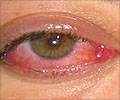A new technique in using contact lenses named overnight orthokeratology (OK) leads to quick improvement in vision for nearsighted patients.

"This study appears to show that it is only, or primarily, the very front surface layers of the cornea that are altered by OK contact lens treatment," comments Anthony Adams, OD, PhD, Editor-in-Chief of Optometry and Vision Science. The study was performed by Jeong Ho Yoon, PhD, of University of Choonhae Health Science, Ulsan, Republic of Korea, and Helen A. Swarbick, PhD, FAAO, of University of New South Wales, Sydney, Australia.
Overnight Orthokeratology Works—But How?
Orthokeratology is a clinical technique to reduce nearsightedness (myopia) using specially designed rigid contact lenses to manipulate the shape of the cornea—the transparent front part that lets light into the eye. Dr Adams likens OK therapy to orthodontic treatment using braces to change the alignment of the teeth.He explains "Wearing these lenses overnight for about six hours is currently the treatment approach for most clinicians who use OK for the temporary correction of low to moderate myopia." But it has been unclear exactly how OK works to reduce myopia: Do the contact lenses reshape just the front surface of the cornea, or do they bend and flatten the entire cornea?
To find out, Drs Yoon and Swarbick had 18 young adults with "low" (relatively mild) myopia wear OK lenses overnight for 14 days. Using sophisticated techniques, the researchers made detailed measurements of corneal shape and thickness before, during, and after treatment.
As in previous studies, wearing OK contact lenses led to reduced myopia, thus improving vision. The changes were significant after the first night wearing OK lenses, By 14 days, myopia was almost completely eliminated and the participants had near-normal uncorrected (without glasses) visual acuity.
Results 'Achieved Primarily through Remodeling of Anterior Cornea'
These changes were linked to significant flattening of the anterior (front) portion of the cornea. Like the vision changes, the change in corneal shape was significant after the first night wearing OK lenses. Although corneal flattening continued throughout the 14-day treatment period, about 80 percent of the change occurred in the first four days.In contrast, OK lenses caused only a small and temporary change in the shape of the posterior (rear) cornea, and only slight thinning of the central cornea. "Overall, our results support the current hypothesis that the OK refractive effect is achieved primarily through remodeling of the anterior corneal layers, without overall corneal bending," according to Drs Yoon and Swarbick.
Advertisement
The authors hope their results "will provide a more complete picture of overall corneal changes during myopic OK." In particular, the study demonstrates that overnight OK lenses don't change the curvature of the posterior cornea—"at least in the first two weeks of lens wear."
Advertisement
Source-Eurekalert













